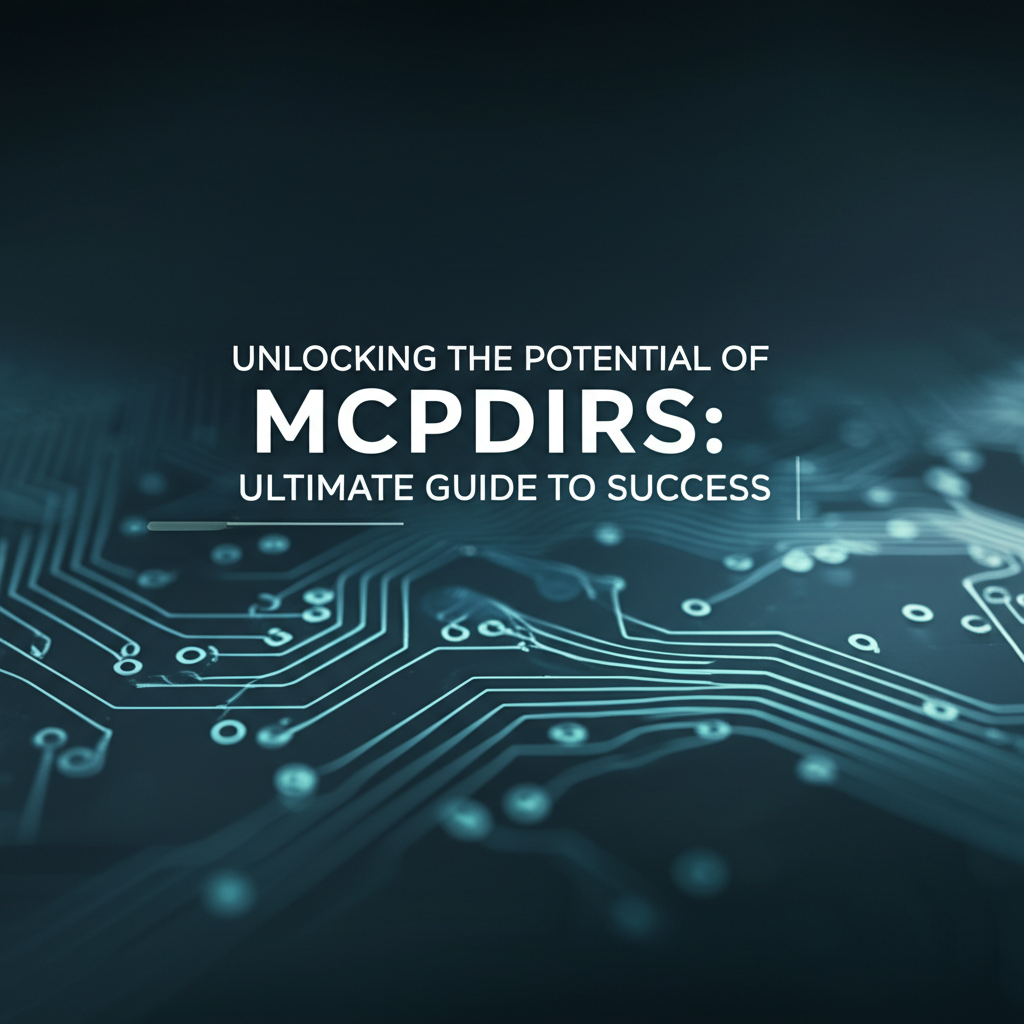Unlocking the Potential of MCPdirs: Ultimate Guide to Success

Build AI Agents With Incredible MCP
Introduction
In the ever-evolving landscape of technology, the Model Context Protocol (MCP) has emerged as a groundbreaking standard for seamless data exchange and interoperability. At the heart of this protocol lies the MCPdir, a crucial component that facilitates the organization and retrieval of model context information. This article delves into the intricacies of MCPdirs, offering a comprehensive guide to leveraging their potential for success. We will explore the role of MCP in modern data ecosystems, the essential tools for working with MCPdirs, and how to maximize their effectiveness. By the end, you will be equipped with the knowledge to navigate the MCP landscape and harness the power of MCPdirs in your projects.
Understanding MCPdirs
What is MCP?
The Model Context Protocol (MCP) is a standardized framework that enables the exchange of context information between different software components and systems. It serves as a common language that allows diverse systems to understand and utilize the context of various data models, thus fostering interoperability and seamless integration.
The Role of MCPdirs
An MCPdir is a specialized directory that contains metadata about models, including their context, structure, and relationships. It acts as a registry, making it easier for applications and systems to discover and interact with the relevant models and their associated data. By providing a structured and standardized approach to model context, MCPdirs enhance the efficiency and reliability of data workflows.
MCP Service: The Backbone of MCPdirs
What is an MCP Service?
An MCP Service is a software component that implements the MCP protocol, enabling the creation, management, and retrieval of MCPdirs. These services are essential for ensuring that models and their contexts are properly indexed and accessible across the data ecosystem.
Key Features of an MCP Service
- Standardized Protocol Support: MCP services must adhere to the MCP protocol to ensure compatibility and interoperability.
- Scalability: They should be capable of handling large-scale data ecosystems with numerous models and MCPdirs.
- Security: Robust security measures are crucial to protect sensitive data and ensure the integrity of the MCPdirs.
- Integration Capabilities: MCP services should offer seamless integration with other data management tools and platforms.
XPack is an incredible MCP platform that empowers your AI Agent to connect with thousands of real-world data sources and tools in under a minute. Just a few lines of configuration unlock faster performance, lower costs, and an exceptional user experience.Try XPack now! 👇👇👇
MCP Tools: Essential for Working with MCPdirs
MCPdir Clients
MCPdir clients are applications designed to interact with MCPdirs, allowing users to search, browse, and manage model contexts. These tools are essential for users who need to access and utilize MCPdirs in their daily workflows.
Example: X-Pack.AI
One of the leading platforms for MCPdir management is X-Pack.AI. X-Pack.AI offers a comprehensive set of tools and services for creating, managing, and utilizing MCPdirs. Its intuitive interface and powerful features make it an excellent choice for organizations looking to harness the full potential of MCPdirs.
Key Features of X-Pack.AI
- User-Friendly Interface: X-Pack.AI provides an easy-to-use interface that simplifies the management of MCPdirs.
- Integration with Existing Systems: The platform offers seamless integration with various data management tools and platforms.
- Scalable Architecture: X-Pack.AI can handle large-scale data ecosystems with ease.
- Robust Security: The platform implements robust security measures to protect sensitive data.
Maximizing the Effectiveness of MCPdirs
Best Practices for Using MCPdirs
- Standardize Model Context: Ensure that all models and their contexts are described using a consistent and standardized format.
- Regular Updates: Keep MCPdirs up-to-date with the latest information about models and their contexts.
- Collaboration: Encourage collaboration among team members to ensure the accuracy and completeness of MCPdirs.
Case Studies
Case Study 1: Improving Data Quality in Financial Institutions
A major financial institution implemented MCPdirs to improve the quality of its data. By standardizing the model context and ensuring regular updates, the institution was able to reduce errors and improve decision-making processes.
Case Study 2: Enhancing Data Integration in Healthcare
A healthcare provider used MCPdirs to streamline data integration across its various systems. This allowed for better patient care and more accurate analytics.
Conclusion
MCPdirs play a crucial role in the modern data ecosystem, providing a standardized and efficient way to manage model contexts. By leveraging the power of MCPdirs and tools like X-Pack.AI, organizations can unlock the full potential of their data and drive success in their respective industries. As the data landscape continues to evolve, the importance of MCPdirs and their associated technologies will only grow, making it essential for organizations to stay ahead of the curve and embrace these innovative solutions.
FAQ
What is the primary purpose of MCPdirs?
MCPdirs serve as a registry for model context information, enabling efficient discovery and retrieval of models and their associated data within a data ecosystem.
How does MCP compare to other data interoperability standards?
MCP stands out due to its standardized approach to model context, ensuring compatibility and seamless integration across diverse systems.
Can MCPdirs be used in any industry?
Yes, MCPdirs can be used in various industries, including finance, healthcare, retail, and more, to improve data management and interoperability.
What are the key benefits of using X-Pack.AI for MCPdir management?
X-Pack.AI offers a user-friendly interface, seamless integration with existing systems, scalability, and robust security features, making it an excellent choice for MCPdir management.
How can I ensure the accuracy of my MCPdirs?
Regular updates, collaboration among team members, and adherence to standardized model context formats are key to ensuring the accuracy of MCPdirs.
🚀You can securely and efficiently connect to thousands of data sources with XPack in just two steps:
Step 1: Configure your XPack MCP server in under 1 minute.
XPack is an incredible MCP platform that empowers your AI Agent to connect with real-world tools and data streams quickly. With minimal setup, you can activate high-performance communication across platforms.
Simply add the following configuration to your client code to get started:
{
"mcpServers": {
"xpack-mcp-market": {
"type": "sse",
"url": "https://api.xpack.ai/v1/mcp?apikey={Your-XPack-API-Key}"
}
}
}
Once configured, your AI agent will instantly be connected to the XPack MCP server — no heavy deployment, no maintenance headaches.

Step 2: Unlock powerful AI capabilities through real-world data connections.
Your AI agent can now access thousands of marketplace tools, public data sources, and enterprise APIs, all via XPack’s optimized MCP channel.

